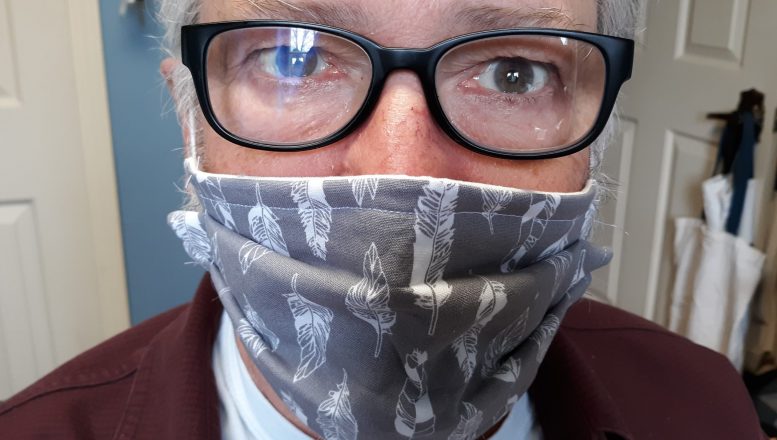By JAN LARSON McLAUGHLIN
BG Independent News
No shirt, no shoes – now add “no mask” – or no service in many cases.
Wood County officials echoed Gov. Mike DeWine’s insistence that as Ohio businesses open back up, it will not be business as usual.
During the weekly conference call with local elected officials on Tuesday morning, Wood County Health Commissioner Ben Batey and Wood County Emergency Management Agency Director Jeff Klein talked about the next steps as Ohio gradually gets back to business.
As of Tuesday, Wood County had 146 confirmed and probable COVID-19 cases, and 20 deaths.
“So obviously we’re still seeing cases increase and periodic deaths,” Batey said. “There are still concerns going on on our end.”
The thought of increased exposure as the stay-at-home order is lifted is daunting – especially when looking at the number of cases in local long-term care facilities, Batey said.
“It truly paints a picture,” he said, “of how quickly this can spread in group settings.”
Ohio still wants to prevent large gatherings to avoid spikes in COVID-19 cases, he said.
But on Monday, DeWine announced the slow roll-out of business openings for Ohio:
- As of May 1, medical services will be opened up for elective surgeries, dental appointments, and visits to general practitioners.
- On May 4, general offices, construction, manufacturing and distribution businesses may open.
- On May 12, consumer retail and services may open.
Batey stressed that these openings come with strings attached.
First and foremost, employees and customers must wear masks – though during Tuesday’s press conference DeWine lifted the mandate for retail customers.
“That’s going to be a little bit difficult for us as a culture,” Batey said. But masks need to become the norm.
Following are the protocols the state outlined for businesses preparing to open:
- No mask, no work, no service, no exception. Require face coverings for employees and clients/customers (except retail) at all times.
- Conduct daily health assessments by employers and employees (self-evaluation) to determine if “fit for duty.”
- Maintain good hygiene at all times – hand washing, sanitizing and social distancing.
- Clean and sanitize workplaces throughout workday and at the close of business or between shifts.
- Limit capacity to meet social distancing guidelines. Establish maximum capacity at 50% of fire code. And, use appointment setting where possible to limit congestion.
Businesses will be asked to adhere to these steps in order to protect the health care system, Batey said.
“They are going to be stretched even thinner,” since hospitals are opening up to elective processes.
Masks don’t need to be professionally made, and can be fashioned from scarves or cut-up T-shirts.
“It doesn’t have to be fancy,” Batey said. “It can be any sort of cloth face covering.”
Just because Ohio is loosening its stay-at-home order, doesn’t mean people should be meeting in groups, Batey added. And just because people are wearing masks, that doesn’t mean they should ignore the 6-foot social distancing recommendations.
“The more we get people together – in any setting – the higher our risks are,” Batey said.
Businesses will be asked to create protective barriers between people if there is not enough space for the 6-foot recommendation.
“It’s up to each individual business to assess all employee areas,” he said.
Many businesses are to remain closed into May, since many cannot meet social distancing while in operation. The following businesses and operations are to remain closed:
- K-12 schools and daycares.
- Restaurants and bars. Carry-out and delivery services are permitted.
- Personal appearance/beauty services. Includes hair salons, day spas, nail salons, barber shops, tattoo parlors, body piercing locations, tanning facilities, massage therapy locations and similar businesses.
- Older adult day care services and senior centers.
- Adult day support or vocational habilitation services in congregate settings.
- Rooming and boarding houses, and workers’ camps.
- Entertainment/recreation/gymnasium sites.
- All places of public amusement, whether indoors or outdoors, such as:
- Laser tag facilities, roller skating rinks, ice skating rinks, arcades, indoor miniature golf facilities, bowling alleys, indoor trampoline parks, indoor water parks, arcades, and adult and child skill or chance game facilities remain closed.
- Gambling industries.
- Auditoriums, stadiums, arenas.
- Movie theaters, performance theaters, and concert and music halls
- Public recreation centers and indoor sports facilities.
- Parades, fairs, festivals, and carnivals.
- Amusement parks, theme parks, outdoor water parks, children’s play centers, playgrounds, and funplexes.
- Aquariums, zoos, museums, historical sites, and similar institutions.
- Country clubs and social clubs.
- Spectator sports, recreational sports tournaments and organized recreational sports leagues.
- Health clubs, fitness centers, workout facilities, gyms, and yoga studios.
- Swimming pools, whether public or private, except swimming pools for single households.
- Residential and day camps.
- Campgrounds, including recreational camps and recreational vehicle (RV) parks.
Many organizations and communities are struggling with whether or not they can hold previously planned social events or activities this summer and fall.
“This isn’t over,” Klein reminded those on the weekly conference call. “You can almost bank on this for the end of the year,” he said of social distancing.
Some events will need to be canceled, but others may be able to be adjusted to allow more space, Klein said. For example, community swimming pools may need to remove or space out chairs if there are concerns about keeping them disinfected.
Wood County Commissioner Ted Bowlus suggested that community swimming pools adopt the following restrictions:
- Limit pool attendance.
- Restrict clustering of people.
- Don’t allow use of water fountains.
- Ban the sale of food and water at pools.
- Screen for sick attendees.
- Monitor the chlorine levels frequently, and perhaps increase the levels.
Bowlus made those suggestions after hearing Pemberville Mayor Carol Bailey express her concerns last week about that village’s pool.
“I know how important the Pemberville pool is to the community and the kids,” Bowlus said.
Batey said the suggestions were good – but may be difficult to implement, especially since by restricting capacity, the pools would be lessening revenues.
“It never makes money anyway,” Bailey said about the town pool.
Bowlus suggested community pools might be able to seek donations to help with operations.
Also during the conference call, Wood County Sheriff Mark Wasylyshyn said the jail was down to 82 inmates, with no known cases of COVID-19 among inmates or deputies.
It was also suggested that the best information about Ohio’s handling of the pandemic can be found at coronavirus.ohio.gov.





